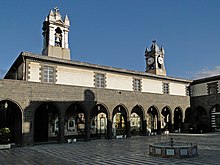| Cathedral of the Dormition of Our Lady | |
|---|---|
كَاتِدْرَائِيَّةُ سَيِّدَةِ النِّيَاحِ لِلرُّومِ الْمَلَكِيِّينَ فِي دِمَشْقَ | |
 | |
 | |
| Location | Damascus, Syria |
| Denomination | Melkite Greek Catholic Church |
| History | |
| Status | Cathedral |
The Cathedral of Our Lady of the Dormition (Arabic: كَاتِدْرَائِيَّةُ سَيِّدَةِ النِّيَاحِ لِلرُّومِ الْمَلَكِيِّينَ فِي دِمَشْقَ, romanized: Kātidrāʾīyat Sayyidat an-Niyāḥ li r-Rūm al-Malakīyīn fī Dimašq), also called the Melkite Greek Catholic Patriarchal Cathedral of the Dormition of Our Lady,[1] is the cathedral of the Melkite Greek Catholic Church[2] in the city of Damascus, Syria.[3] It is the seat of the Greek-Melkite Archeparchy of Damascus (Latin: Archieparchia Damascena Graecorum Melkitarum) dependent on the Melkite Catholic Patriarchate of Antioch, which includes about 150,000 baptized adherents and twenty parishes with fifty priests. Its faithful, assigned from the 18th century to the Holy See in Rome, employ the Arabic language and the Byzantine rite.
The Archbishop Vicar (or Eparca) starting in 2006 was Youssef Absi, former Superior General of the Society of Missionaries of St. Paul. On June 21, 2017, he was elected as the Melkite Greek Patriarch.[4]
The cathedral is dedicated to the Dormition of the Virgin, the Eastern Christian "counterpart" to the Latin Church doctrine of the assumption of Mary.
See also
[edit]
References
[edit]- ^ Cathedral of the Dormition of Our Lady
- ^ Correspondent, a Times Special (2013-09-09). "Damascus residents fear a U.S. strike will bring rebel onslaught". Los Angeles Times. ISSN 0458-3035. Retrieved 2016-11-24.
{{cite news}}:|last=has generic name (help) - ^ "ADDRESS TO YOUNG PEOPLE IN DAMASCUS". www.ewtn.com. Archived from the original on 2017-10-11. Retrieved 2016-11-24.
- ^ "Joseph Absi elected patriarch of the Melkite Greek Catholic Church". The Daily Star (Lebanon). Archived from the original on 18 January 2021. Retrieved 21 June 2017.
External links
[edit] Media related to Cathedral of the Dormition of Our Lady at Wikimedia Commons
Media related to Cathedral of the Dormition of Our Lady at Wikimedia Commons- www.gcatholic.org

Well, that’s interesting to know that Psilotum nudum are known as whisk ferns. Psilotum nudum is the commoner species of the two. While the P. flaccidum is a rare species and is found in the tropical islands. Both the species are usually epiphytic in habit and grow upon tree ferns. These species may also be terrestrial and grow in humus or in the crevices of the rocks.
View the detailed Guide of Psilotum nudum: Detailed Study Of Psilotum Nudum (Whisk Fern), Classification, Anatomy, Reproduction